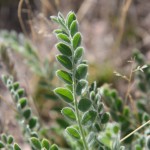Woolly Locoweed, Purple Locoweed, Woolly Loco
Astragalus mollissimus Torr.
Fabaceae (Legume family)
Description
Woolly Locoweed, aka Purple Locoweed, is a stout, many-branched, densely hairy, perennial of the Legume (Fabaceae) family. While its inner branches turn upward forming a rounded shape, its thick, woody root gives rise to outer stems lying close to the ground. The plant is less than 1 ft or 30 cm high. Woolly Locoweed leaves are alternate, compound pinnate, and 5-10 cm long. Its leaves have 19 to 29 leaflets (20-38 mm) that are thick, oval to oblong in shape, and covered with fine, soft, short hairs. The leaves are generally basal and often lie on the ground. The 2.5 cm flowers are quite variable in color ranging from purple, lavender, or yellowish white. Blooming may occur from March to July. They mature into thick, inflated, densely hairy, moon-shaped seedpods. The flowers come from the axils on the upper 5 to 10 cm of the stems in long spikes of 5 to 35 flowers. The flowers have five petals and five sepals. The upper banner petal is upright, and the lower petals are often lighter colored. This plant is poisonous to all species of livestock and wildlife. Astragalus mollissimus is quite a variable species with multiple sub-species of varying flower colors, pubescence, and size.Habitat
Woolly Locoweed grows from southwestern South Dakota to Texas and New Mexico. It prefers dry sands or gravelly soils. It is common in upland, mesa, and mountain areas of the Trans-Pecos and Panhandle regions of Texas.Toxic Agent
Woolly Loco is toxic to cattle, sheep, goats, and particularly horses. Its toxin is swainsonine, which causes damage to the brain, liver, digestive organs, placenta, and testes. The damage is reversible except in the brain. “Locoism” occurs in cattle and sheep after they have eaten about 90 percent of their body weight of the plant in a 2- month period. Ruminants usually must eat from 200 to 350 percent of their body weight over several months before death occurs. In horses, about 30 percent of body weight consumption produces signs.Signs of Livestock Ingestion
Poisoning signs develop from the involvement of sensory and motor functions. In cattle, general signs include: carrying the head a little lower than normal, a vacant stare, trembling of the head, difficulty eating and drinking, and abortion. Individuals may show signs of nervousness and have irrational or spastic movements. Swainsonine is passed in the milk, possibly leading to unthrifty offspring in some suckling calves. In horses, the time between the first clinical signs and death is much shorter than in cattle. The poisoned horse is listless, but upon being stimulated, becomes excessively excited. Horses with chronic “locoism” rarely recover and are permanently dangerous to ride.Management Strategies
Quickly move affected animals to Locoweed-free pastures and place them on good feed. Management to reduce Locoweed poisoning is most critical in early spring. Livestock imported from areas where Locoweed does not grow are the most susceptible to poisoning. Native animals generally avoid Locoweed when good quality forage is available. Maintaining good range condition and sound supplemental protein and mineral feeding programs are the best prevention against losses. Locoweed dominating a particular area can be controlled chemically. Individual plant treatments or broadcast treatments with Grazon P+D® are effective. Locoweed becomes much more toxic and palatable after chemical application until it is completely dried up.Images
Plant Characteristics
Flower Color: Purple, White, Yellow
Seed Type: Bean/Pod
Duration: Perennial
Stem Texture: Hairy
Growth Habit: Forbs/Broadleaf
Leaf Shape
 : Bipinnately Compound
: Bipinnately Compound
Season: Warm
Distribution
 : 07 - Edwards Plateau, 08 - Rolling Plains, 09 - High Plains, 10 - Trans-Pecos
: 07 - Edwards Plateau, 08 - Rolling Plains, 09 - High Plains, 10 - Trans-Pecos
Distributions
Distribution refers to the ecological region in Texas that a plant has been found. You can also view a clickable map.
Book: Brush and Weeds of Texas Rangelands (B-6208), Toxic Plants of Texas (B-6105)
Collection: Brush and Weeds, Toxics, Wild Flowers
Livestock Affected: Cattle, Goats, Horses, Sheep
Livestock Signs: Abortion, Excitability, Lethargy/Listlessness, Trembling, Unable To Eat/Drink, Unthrifty Offspring









